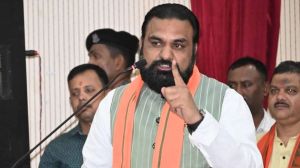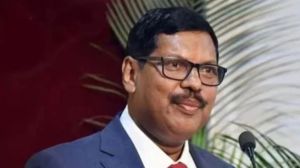The Big Shift
Four friends started an editing studio in a Mumbai garage 15 years ago. It is now an MNC that has worked on the visual effects of Avatar
Four friends started an editing studio in a Mumbai garage 15 years ago. It is now an MNC that has worked on the visual effects of Avatar
The Sky People are plotting to attack Pandoras Home Tree. The fate of the planet is at stake. The air is tense. Yet,the scene is as flat as the green table at the centre. That was till the shots arrived at the Prime Focus laboratory. Once there,these sequences acquired 3D effects,turned dramatic as holographic maps were introduced,and director James Camerons vision of the planet Pandora took shape.
When the Prime Focus team in Los Angeles got the opportunity to work on Avatar early last year,it wasnt time to celebrate. Instead,the company had to garner all their resources. Within a few weeks,a team of 90 people,drawn from across Prime Focuss Los Angeles,Vancouver and Winnipeg facilities,was put together to execute this project. It was headed by visual effects veterans Chris Bond and Chris Del Conte.
The team oversaw the design of the motion graphics and a bulk of Prime Focuss work was done for the Bio lab and Ops Center,the bustling hub for military operations and one of the key environments in the film. In short,the Holotables at Sky Peoples Ops Centre looked like empty billiard tables till Prime Focus worked on them.
The company has also worked on other films like The Twilight Saga: New Moon (where they added the glow to the ever-so-attractive vampires), GI Joe: The Rise of Cobra,X Men Origins: Wolverine and Watchmen.
Prime Focus has studios across the UK and the US,and in Hyderabad,Bangalore,Goa and Mumbai. Today,it is one of the biggest names in India in the field of post-production work and special and visual effects. As is with most entrepreneurial ventures,it had a modest start from a garage in Mumbai 15 years ago.
The CEO and founder member Namit Malhotra recounts the beginning of this unlikely adventure. I come from a film familymy grandfather was a cinematographer with BR Chopra and my father was a producer who also supplied cameras to film and television units. Being a part of this industry was in my blood. But I didnt want to do the same. So dad suggested I look at editing, says Malhotra.
The 19-year-old enrolled in a computer institute to learn computer graphics. When I planned to purchase a computer-based editing machine,I asked my teachersMerzin Tavaria,Hufeza Lokhandwala and Prakash Kurup who were merely 21 years old then and were teaching graphics as a hobby to become my partners in the project. They agreed and we then started our company,Video Workshop from the garage of my Santacruz residence.
The biggest challenge then,says Malhotra,now 33,was that computer-based editing systems were a new technology and hence relatively unknown to the industry. Instead of swimming with the tide,the four entrepreneurs used this as an opportunity to become the first computer-based post-production house and started with low-end projects for strugglers in the Indian television industry.
But success was instant, says Kurup. We had paved the way for the industry. In two years,we had purchased another five editing machines,had 21 shows on air,with a turnover of Rs 95 lakh when our initial investment was Rs15 lakh. Our advantage was that we never went back to conservative technology. If there was something new in the market,we were the first to try it in India. We would start from scratch to first educate ourselves and then our clients.
In 1997,the four friends took the next big leap and formed Prime Focus. Slowly,the company grew out from the garage and spread its wings to establish its presence across four Indian cities,the UK and the US.
Malhotra says the companys biggest asset is its team. Hiring wasnt based on experience. If you were a fresher but willing to learn and work hard,you were on. The benefit was that people didnt come with baggage and could mould according to the need. The first 25 people Prime Focus hired had no prior experience but today,occupy key positions at Prime Focus, he says.
The four friends admit that they have face their share of adversities. Months after we set up our Adlabs facility,it burned down. The day we hosted our press conference to introduce our IPO,the Sensex crashed and the media rushed from my event to Dalal Street; it was the fateful Black Monday, Malhotra says. Soon after an acquisition in the UK,writers and then actors went on strike. And recently, when we re-branded our facilities across the globe,the UK and the US sank into recession. We have had no choice but fight it out, he says.
In times when people prefer to not mix work with friendship,these pals have stuck it out. They smile at the suggestion,and 34-year-old Tavaria,now the chief creative director of Prime Focus,reveals their secret: Weve never interfered with each others areas of work. Huzefa,Prakash and I are childhood friends,and have always been at the creative end while Namit took the business decisions. Namit trusts our judgment and we have complete faith in him as the business head.
After a promising first 15 years,the quartet is now looking at a fruitful next decade. With a research facility set up in Bangalore,Prime Focus has developed a platform called CLEARto help clients manage media content across various platformsdigital,mobile,Internet or any other form of new media. We are looking at patenting it now, says Malhotra.
The four friends are wary of slipping into a comfort zone. With every technological development,weve had to start all over again. So we still feel like entrepreneurs starting out. That never lets us get jaded, says Malhotra
THE JOURNEY
*Prime Focus was started in 1997 in a garage in Santacruz,Mumbai.
*In 2004 came their first equity investment from Adlabs. Prime Focus set up their studio in the Adlabs premises at Goregaon,the heart of Mumbais film industry
*Reliance picked up a 15 per cent stake in the company in 2005. Soon after,in 2006,they went public.
*Already present across four cities in India,Prime Focus,in 2007,bought over VTR plc,a UK-based studio,for 4.7 million,and followed this up with Frantic Films and Post Logic,two renowned facilities in North America,at $ 43 million.
*In 2009,they re-branded these facilities as Prime Focus to build upon the brand and brought in credible names,like Academy Award-winning special effects veteran Michael Fink who had worked on The Golden Compass. Their first international special effects project was the film Journey to the Centre of the Earth.



- 01
- 02
- 03
- 04
- 05




























